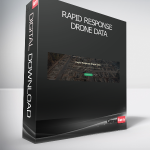Rapid Response Drone Data
$79.00
His company was founded from extensive experience in academic research and teaching, as well as the commercial drone industry. Prior to Scholar Farms, Greg was the Sales Director for the scientific and academic verticals at Pix4D and Parrot, and the Academic Programs Director at 3D Robotics. While serving academia, Greg was an Assistant Professor of Ecology at the University of British Columbia.
- Description
- Reviews (0)
Description
Rapid Response Drone Data
The Masterclass Curriculum
Rapid Response Drone Data is a course emerging from real-world experience mapping with public safety teams in the aftermath of disasters. The goal of the course is to scale drone education for people needing to rapidly collect and visualize drone data for emergency response, including many tips and tricks from devastating wildfires in California. This course walks students step-by-step through everything you’d need to know to become a digital first responder using off-the-shelf drones.
The theory behind drone mapping
Best-practices for image capture
Drone and camera hardware
Mission planning software
Image processing and data outputs
Cloud tools
Lessons learned the hard way so you don’t have to
The Instructor
Dr. Greg Crutsinger is the founder of Scholar Farms, which specializes in using drone training for aerial mapping. He has acted as the emergency drone data lead for three major wildfires in California, including the Tubbs, Carr, and Camp Fires.
His company was founded from extensive experience in academic research and teaching, as well as the commercial drone industry. Prior to Scholar Farms, Greg was the Sales Director for the scientific and academic verticals at Pix4D and Parrot, and the Academic Programs Director at 3D Robotics. While serving academia, Greg was an Assistant Professor of Ecology at the University of British Columbia.
Frequently Asked Questions
Who is this masterclass for?
Built for a broad audience at all skills levels
Agencies and Departments
If you are member of a public safety team interested in or currently building your drone program, then this course was built for you. It will walk you through the transition from simply flying a drone for an active scenario to collecting valuable point surveys and map layers. This class is not just theory, it was built from real-world experience providing situational awareness during disasters.
First Responders
Are you a citizen looking help out your local community when it really counts? This course will teach you how to prepare, what to expect, and how to best capture drone information. It will deliver different hardware and software options, tips and tricks, and the outputs your local agencies can use during an emergency.
Drone Service Providers
Know what clients expect during an emergency, how to best capture that data for them, and how to present completed mapping data. With this class, you can go from flying basic missions through delivering perfect results for public safety teams and coordinating agencies.
More questions? Contact [email protected] or visit Scholar Farms
“You can’t build a public safety UAV team without thinking about the data side of the equation. Its not enough to be a great pilot. The maps and imagery also have to get to the right place. Watching Greg work both on scene during these wildfires and his followup afterward has been a big boost to our UAV program.”
– Deputy Sheriff Casey Tholborn, Contra Contra County Sheriff’s Office
“Greg has worked right alongside our team during these devastating wildfires, keeping a level head and applying his valuable skillset from industry and academia to assist the communities in California. He is one of the best out there to train on the UAV data side.”
– Deputy Sheriff Rick Hassna, Chief UAS Pilot, Alameda County Sheriff’s Office
“As a volunteer drone pilot during the mapping of the Camp Fire, I watched first hand as Greg coordinated an incredible amount of data and helped condense it down for the teams and the public. More agencies need the kind of data skills that this Rapid Response class provides.”
– Andrew Maximow, Chief Drone Officer, Firmatek
“I’ve been following Greg’s excellent work for some years now. His direct, hands-on field experience coupled with his technical expertise, data-savviness and strong academic credentials makes him a go-to expert for many of us in the humanitarian drone space. What’s more, Greg is refreshingly humble and wonderfully creative as demonstrated by his practical, hands-on problem solving attitude. I’ve learned heaps from him and continue to do so. Be sure to check out his new course!”
– Dr. Patrick Meier, Executive Director, WeRobotics
“Public safety has embraced the benefits that emerging technology like UAS can provide during disaster response and the recovery phase. Scholar Farms has built an outstanding operational template to best optimize the large amounts of data that public safety teams collect with UAS in the field. During recent wildfires here in California, I got to see how Greg organized and delivered a comprehensive package of usable information to emergency managers and the public. More teams need this skillset.
After taking Rapid Response Drone Data, I feel abundantly more prepared to respond to a disaster. This is particular relevant for us here in earthquake-prone San Francisco, where it will be crucial to know how to best collect, process, and deliver data to achieve our collective mission of effective emergency response”
– Katharine Cook, San Francisco Police Department
“Dr. Greg Crutsinger is a former colleague of mine at 3DR and someone I have a ton of respect for. He has been figuring out ways to use a combination of drone software platforms to provide a truly valuable solution for first responders and residents of the tragic fires hammering California.”
– Colin Guinn, Founder, Guinn Partners
Inspiration For the Course
A Overview of the Coordinated Team Effort it Takes to Get the Job Done
Course Curriculum
Section 1: Introduction
Emergency UAV Mapping in the Fire Zones (Background Video) (5:08)
Intro 1: Welcome to the Class! (3:14)
Intro 2: Instructor Background (2:46)
Intro 3: Going From Science to Wildfires (3:00)
Intro 4: Setting Expectations for the Course (3:04)
Example Data Products from Tubbs, Carr, and Camp Fires
Short Initial Student Survey
Checklists, Cheatsheets and Course Resources
Checklist – Pre-Mission Planning
Cheatsheet- Rapid Response Workflow
Cheat Sheet – Mapping Best Practices
Survae Experiment White Paper
Satellite, Manned, and Unmanned Imagery Guide
Section 2: Background History of the Commercial Drone Industry
Industry Overview Introduction (1:18)
Overview 1 – History of Aerial Imagery (3:36)
Overview 2 – Very Short History of Unmanned Systems (4:11)
Overview 3 – Rise of Consumer Drones (2:49)
Overview 4 – DJI Emerges as a Leader (2:44)
Overview 5 – Part 107 and the Commercial Industry (2:52)
Overview 6 – Commercial Hardware Gets Better (1:36)
Overview 7 – Moving From Hardware to Software (4:42)
Overview 8 – The Uphill Battles in the Industry (3:35)
Overview 9 – Whats the Future of the Industry (4:21)
Industry Overview Wrap-Up (2:19)
Section 3: Pre-Mission Planning for Rapid Response
Rapid Response Planning Introduction (2:21)
Planning Lecture 1 – Determining the Scope of the Mission (3:24)
Planning Lecture 2 – Gather Intelligence on the Area/Damage (2:42)
Planning Lecture 3 – What Data Products are Being Requested? (2:33)
Planning Lecture 4 – Understanding Infrastructure (1:33)
Planning Lecture 5 – Is Your Software Up to Date? (4:56)
Planning Lecture 6 – Team Organization (5:24)
Planning Lecture 7 – Debriefing Pilots (3:01)
Planning Lecture 8 – Dividing Teams, Communication (4:15)
Planning Lecture 9 – Standardizing Methods, Rapid Training (3:49)
Planning Lecture 10 – Handing Off the Data (6:13)
Planning Lecture 11 – Take Care of Yourself (1:54)
Section 4: Video Blogs From the Carr Fire
Carr Fire Vlogs Introduction (2:20)
Carr Fire Vlog 1 – Early rise and flying up (1:40)
Carr Fire Vlog 2 – Debrief in Redding (1:04)
Carr Fire Vlog 3 – Oops, got left behind (0:31)
Carr Fire Vlog 4 – Getting up in the air (1:01)
Carr Fire: Vlog 5 – A walk through the neighborhood (0:34)
Carr Fire Vlog 6 – Helicopters in the area (0:38)
Carr Fire Vlog 7 – End of the day processing (0:36)
Carr Fire Vlog 8 – Headed back out (0:30)
Carr Fire Vlog 9 – Second day debrief and early results (0:42)
Carr Fire Vlog 11 – Rogues drones in a neighborhood (0:22)
Carr Fire Vlog 12 – A hard hit neighborhood (0:42)
Carr Fire Vlog 13 – Talking to customer support as we load data (0:46)
Carr Fire Vlog 14 – Wrapping up and heading home (0:27)
Section 5: Drone Hardware
Hardware Lecture 1 – P4P (4:17)
Hardware Lecture 2 -Mavic 2 Pro (6:16)
Hardware Lecture 3 – Parrot Anafi (4:26)
Hardware Lecture 4 – Fixed Wings (3:26)
Hardware Lecture 5 – DJI Goggles (3:33)
Hardware Lecture 6 – A Note on Hard Cases (1:33)
Section 6: Georeferenced Video Using Survae
Introduction to Survae (2:02)
Lecture 1 – Survae Software Walkthrough of the Workflow (5:08)
Lecture 2 – Survae Software, How to Upload Your Data (4:26)
Lecture 3 – Survae Software, How to Share Your Data (2:18)
Example Video Embed #1
Example Video Embed #2
Section 7: Flight Log mapping using the drone as a flying GPS
Flight log Mapping (Background Video) (6:12)
Introduction to Flight Log Mapping (3:26)
Lecture 1 – Flight Log Litchi (3:55)
Lecture 2 – Flight Log Mapping Survae Export (3:47)
Lecture 3 – Flight Log Mapping Airdata (7:07)
Lecture 4 – Flight Log Mapping Example A (3:44)
Lecture 5 – Flight Log Mapping Example B (2:00)
Lecture 6 – Flight Log Mapping Example C (2:12)
Section 8: 360 Panoramas
Introduction to 360 Panoramas (3:00)
Lecture 1 – Hangar 360 (4:20)
Lecture 2 – Hangar 360 (3:42)
Lecture 3 – Hangar 360 (1:16)
Lecture 4 – Hangar 360 (1:35)
Lecture 5 – Hangar 360 (1:42)
Lecture 6 – Panos With DJI Go 4 (3:03)
Lecture 7 – Round Me (4:58)
Lecture 8 – Round Me (3:11)
Lecture 9 – Round Me (3:19)
Lecture 10: PT Gui for Offline Stitching (10:03)
Hands on Lab
Photos for 2D and 3D processing
Section 9: Mapping With Drones Theory & Best Practices
Introduction to Mapping Theory (0:50)
Theory 1 – The Science of Remote Sensing (3:10)
Theory 2 – Light and the Electromagnetic Spectrum (3:09)
Theory 3 – Digital Cameras on Our Drones (4:26)
Theory 4 – An Introduction to Photogrammetry (4:28)
Theory 5 – An Overview of Orthomosaics (2D Maps) (3:52)
Theory 6 – Nadir Versus Oblique Imagery (4:06)
Theory 7 – Flight Speed (2:37)
Theory 8 – Rolling Versus Global Shutter (2:35)
Theory 9 – Altitude and Ground Sampling Distance (2:34)
Theory 10 – Dealing With Sloped Terrain (3:09)
Theory 11 – Relative Versus Absolute Accuracy (2:44)
Theory 12 – An Overview of RTK GPS (3:12)
Theory 13 – Using Ground Control to Improve Accuracy (4:21)
Wrap-Up Mapping Theory (1:07)
Section 10: Deep Dive Into Pix4D
Introduction to Pix4D Software (2:51)
Pix4D Background Lecture 1 (5:08)
Pix4D Background Lecture 2 (1:53)
Pix4D Background Lecture 3 (5:22)
Pix4D Background Lecture 4 (4:20)
Pix4D Cloud Lecture 1 (1:55)
Pix4D Cloud Lecture 2 (7:02)
Pix4D Cloud Lecture 3 (2:49)
Pix4D Desktop Lecture 1 (7:37)
Pix4D Desktop Lecture 2 (5:16)
Pix4D Desktop Lecture 3 (Step 1) (1:57)
Pix4D Desktop Lecture 4 (Step 2) (3:39)
Pix4D Desktop Lecture 5 (Step 3) (3:35)
Pix4D Desktop Lecture 6 (5:01)
Pix4D Desktop Lecture 7 (7:15)
Pix4D Desktop Lecture 8 (5:29)
Pix4D Desktop Lecture 9 (2:31)
Pix4D Desktop Lecture 10 (5:21)
Pix4D Desktop Lecture 11 (2:57)
Pix4D Desktop Lecture 12 (6:51)
Pix4D Desktop Lecture 13 (3:59)
Pix4D Desktop Lecture 14 (4:02)
Section 11: Autonomous Mission Planning Software
Introduction to Mission Planning (2:42)
Lecture 1 – Pix4D Capture (6:37)
Lecture 2 – Map Pilot by Maps Made Easy (10:43)
Lecture 3 – Drone Deploy Overview (3:06)
Lecture 4 – Drone Deploy Mission Planning (6:09)
Lecture 5 – Drone Deploy Uploading Photos (1:59)
Lecture 6 – Drone Deploy Mapping Results (3:13)
Lecture 7 – Drone Deploy Live Map (3:50)
Wrap-Up Mission Planning (1:01)
Section 12 Pix4D Fields for Rapid Mapping
Introduction to Pix4DFields (7:24)
Lecture 1 -Pix4D Fields Walkthrough (6:08)
Lecture 2 – Introduction to Google Earth (7:44)
Lecture 3 – Pix4Dfields to Google Earth (4:06)
Section 13: Camp Fire Technical Debrief
Camp Fire Introduction (0:52)
Camp Fire 1 – How the Fire ed (4:26)
Camp Fire 2 – Early Structure Damage Map (3:32)
Camp Fire 3 – Preparing to Go (4:35)
Camp Fire 4 – Experimenting on the First Day (4:59)
Camp Fire 5 – A Break to Prep (5:28)
Camp Fire 6 – Preplanning Missions in Drone Deploy (2:36)
Camp Fire 7 – Data Capture With Multiple Teams (3:46)
Camp Fire 8 – Exporting the Data from Drone Deploy (4:29)
Camp Fire 9 – Hangar 360 Pano Capture (6:39)
Camp Fire 10 – Manually Uploading Hangar Panos (3:29)
Camp Fire 11 – Looking Through Some Data (3:16)
Camp Fire 12 – What Layers Were Made Public (6:48)
Camp Fire 13 – Data Layers Continued (2:42)
Camp Fire 14 – The Survae Experiment (10:04)
Camp Fire 15 – Manned Aircraft 2D Results (4:19)
Camp Fire 16 – Manned Aircraft 3D Results (4:50)
Camp Fire 17 – Satellite Data (5:39)
Post-Camp Fire Write-up
Section 14: Camp Fire Vlogs
Get Rapid Response Drone Data download
Camp Fire Vlogs: Day 1 (9:54)
Camp Fire Vlogs: Day 2 (5:29)
Camp Fire Vlogs: Day 3 (10:29)
Camp Fire Vlogs: Day 4 (8:35)
Camp Fire Vlogs: Day 5 (13:51)
Camp Fire Vlogs: Day 6 (9:25)
Camp Fire Vlogs: Day 7 (6:17)
Camp Fire Vlogs: Day 8 (2:51)
Camp Fire Vlogs: Final Data Handoff (2:16)
Section 15: Course Wrap Up
Course Wrap-up Lecture 1 (6:35)
Course Wrap-Up Lecture 2 (2:16)
Read more: https://archive.is/0a49h





Reviews
There are no reviews yet.